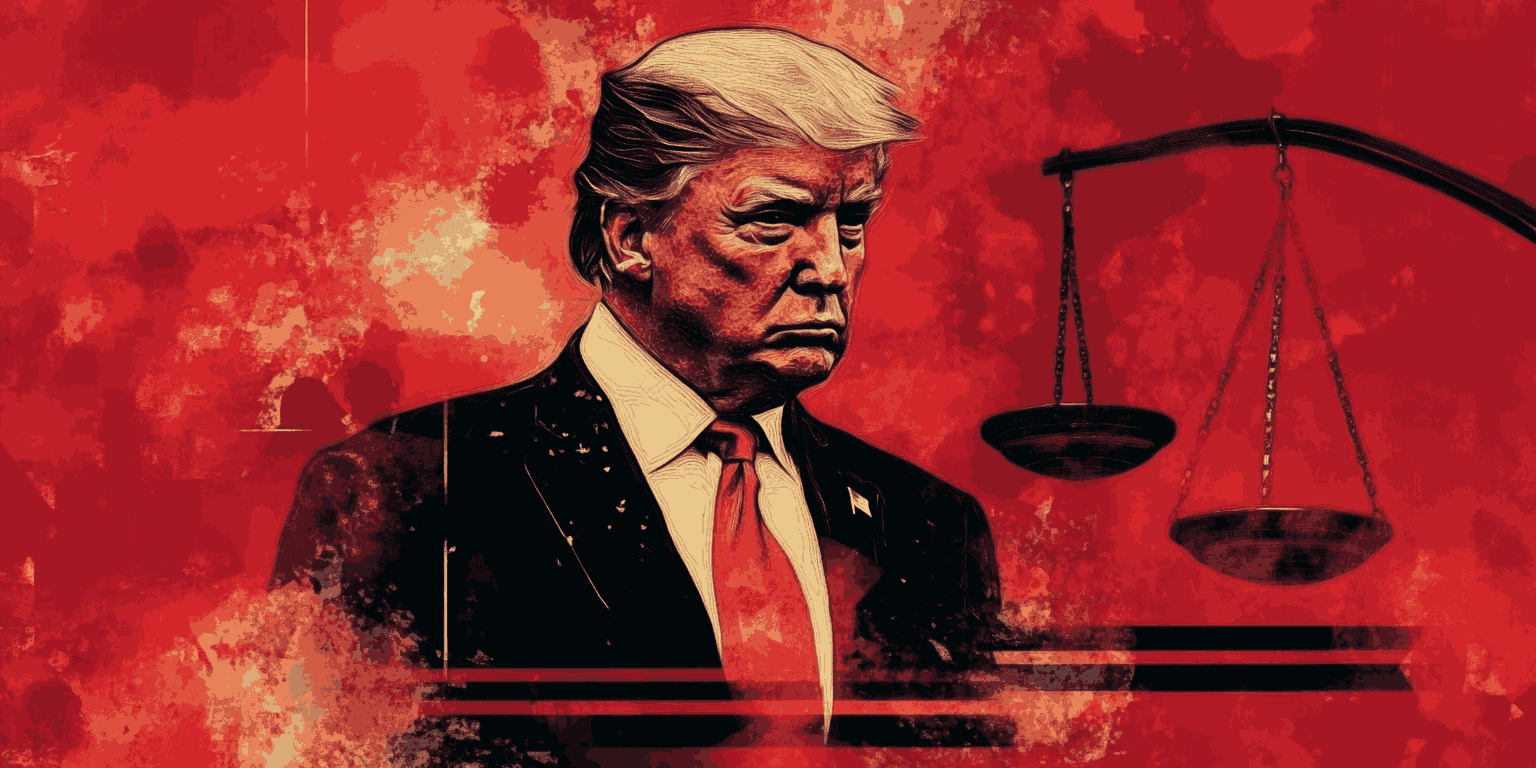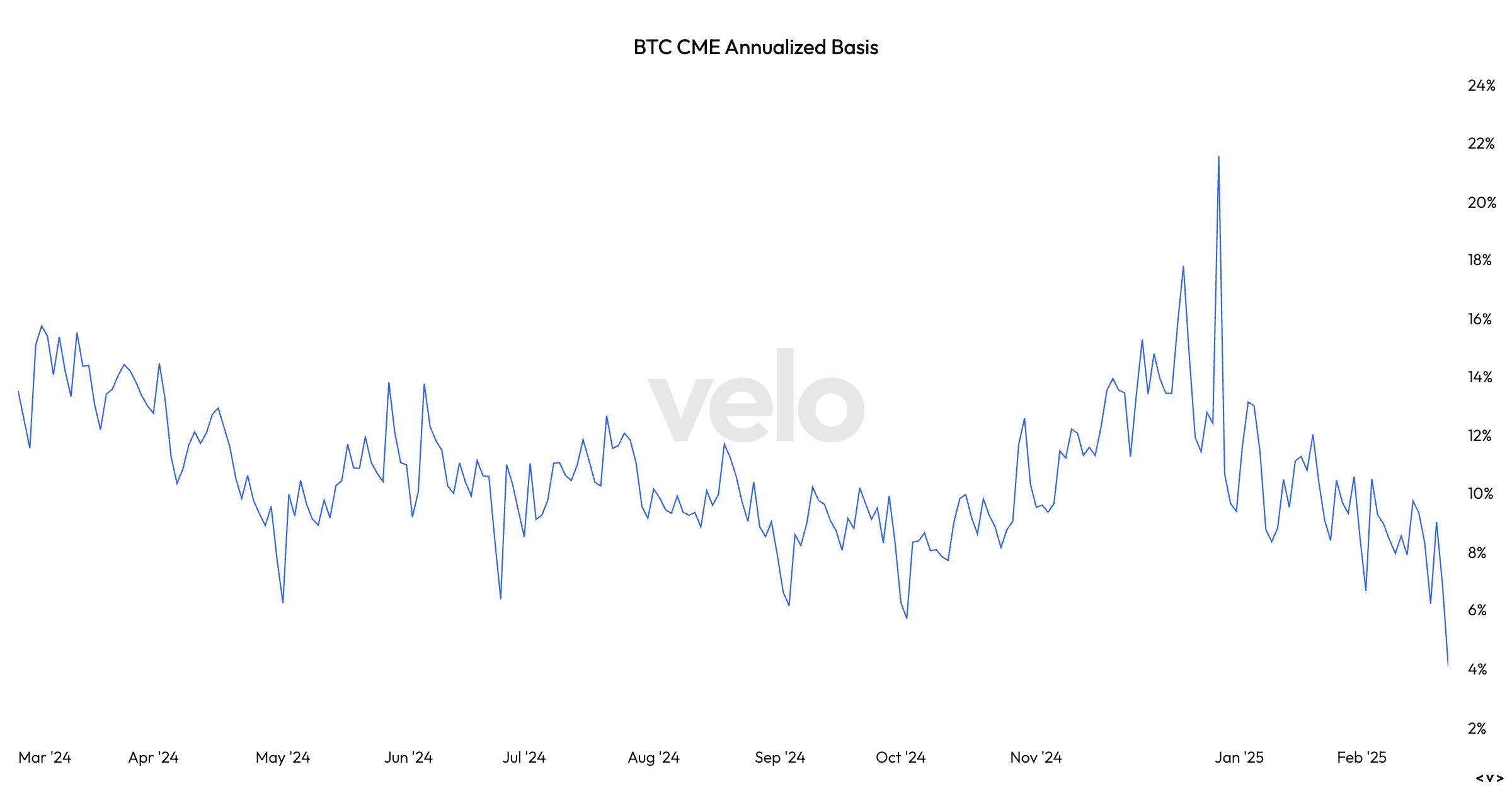
Crypto market capitalization is down 8% on the day, plunging below $3.1 trillion on Feb. 25 following a wipeout of almost $200 billion in 24 hours. This is the lowest markets have been since mid-November, obliterating almost all gains since Donald Trump’s election victory. Total cap is now teetering on longer-term support levels, and a fall below $3 trillion will see these levels broken and a potential end to the bull market. $1B in Liquidations Coinglass reported that more than 314,000 traders have been liquidated over the past 24 hours to the tune of almost a billion dollars. Over 90% of the liquidations were in long positions and the largest single liquidation order happened on BitMEX with $10 million worth of Bitcoin. Bitcoin dumped more than 5% in a matter of hours, falling from $96,000 to $91,000, its lowest level since mid-January. At the time of writing it appeared to have found support there and reclaimed $91,500 during the Tuesday morning Asian trading session. Ethereum lost around 10%, falling back below $2,500. However, it is showing little signs of a recovery bounce . The Altcoins have been obliterated with double-digit losses for Solana (SOL), which is now down more than 50% in a little over a month following the meme coin bubble bursting. Chainlink (LINK), Avalanche (Avax), Sui (SUI), and Hyperliquid (HYPE) were also in double-digit losses this morning. Analysts are generally unfazed, having seen this market behavior many times before. Prepare for both scenarios, well in advance. If you’re caught by this move, feeling unsure about what to do, it means you didn’t have a plan. Low $90ks is the first leg of my plan, and the air-pocket below $86k is the second. Higher eventually, have a plan for that too. — _Checkmate (@_Checkmatey_) February 25, 2025 Fear and Greed The Bitcoin Fear & Greed Index has plunged to its lowest level since September, hitting “extreme fear” at 25 on Tuesday, following neutral readings for the past week or so. On the upside, there have been several similar market meltdowns in recent months, including a 7.5% crash on Dec. 9, a 10% meltdown on Dec. 19, a 7.5% slump on Jan. 7, and an 8% dump on Feb. 2, which markets never recovered from. Macro investor Raoul Pal pointed out that these massive pullbacks have happened in previous cycles and are perfectly normal. You guys all need to learn patience… This was 2017. Very similar macro structure: 5 x 28%+ pullbacks in BTC Most lasted 2 to 3 months before a new high Alts saw 65% corrections. All were noise. Go do something else more constructive than stare at the screen. pic.twitter.com/jGyiOgKlYE — Raoul Pal (@RaoulGMI) February 24, 2025 The post $200 Billion Exits Crypto Space as Markets Plunge to Support appeared first on CryptoPotato .
Crypto Potato
You can visit the page to read the article.
Source: Crypto Potato
Disclaimer: The opinion expressed here is not investment advice – it is provided for informational purposes only. It does not necessarily reflect the opinion of BitMaden. Every investment and all trading involves risk, so you should always perform your own research prior to making decisions. We do not recommend investing money you cannot afford to lose.
Uncovered: US Authorities Seize $31 Million in Crypto from Uranium Finance Exploit

In a significant move highlighting the increasing capabilities of law enforcement in the digital asset space, U.S. authorities have seized a staggering $31 million in cryptocurrency. This crypto confiscation is directly linked to the 2021 exploit of Uranium Finance, a decentralized finance (DeFi) platform. This operation, spearheaded by the Southern District of New York (SDNY) and Homeland Security Investigations (HSI), sends a clear message to cybercriminals: the long arm of the law extends into the blockchain. Decoding the Crypto Confiscation: What Happened? Let’s break down this significant development. The operation centers around the 2021 hack of Uranium Finance. To understand the recent crypto confiscation , it’s crucial to revisit the original incident: Uranium Finance Exploit (April 2021): Uranium Finance, an automated market maker (AMM) operating on the Binance BNB chain, suffered a sophisticated cyberattack. Vulnerability Exploited: Hackers targeted a vulnerability within Uranium Finance’s pair contracts. This flaw allowed them to manipulate the system and siphon off funds. Massive Theft: The cybercriminals successfully stole approximately $50 million worth of cryptocurrency in the Uranium Finance exploit . This was a major blow to the DeFi platform and its users. Silent Pursuit: Unbeknownst to many, U.S. law enforcement agencies, including SDNY and HSI, initiated an investigation to track down the stolen funds and the perpetrators behind the Uranium Finance exploit . Cryptocurrency Seizure: A Win for Law Enforcement Fast forward to the present, and the efforts of these agencies have borne fruit. The recent announcement of the cryptocurrency seizure of $31 million marks a significant milestone in the fight against crypto crime. This operation demonstrates several key points: Inter-Agency Collaboration: The success of this operation highlights the effective collaboration between different U.S. law enforcement agencies, specifically SDNY and HSI. Their combined expertise was crucial in tracing and recovering the digital assets. Advanced Tracking Capabilities: Despite the pseudonymity often associated with cryptocurrency transactions, authorities are developing and utilizing sophisticated tools and techniques to trace the flow of illicit funds across blockchains. This cryptocurrency seizure is a testament to these advancements. Deterrent Effect: Public announcements of such successful seizures serve as a powerful deterrent to potential cybercriminals. It sends a clear message that illicit activities in the crypto space will not go unpunished, and there are real-world consequences. Partial Recovery: While the seized amount is substantial, it’s important to note that it represents roughly $31 million of the $50 million stolen in the Uranium Finance exploit . The investigation likely remains ongoing to recover the remaining funds and bring the perpetrators to justice. DeFi Hack Recovery: Is This a Turning Point? The DeFi hack recovery in the Uranium Finance case raises important questions about the future of decentralized finance security and regulation. Is this seizure a turning point? Here are some considerations: Aspect Implication Increased Law Enforcement Focus We can expect to see more proactive investigations and interventions by law enforcement agencies in the DeFi space. This DeFi hack recovery sets a precedent. Enhanced Security Measures DeFi platforms and developers will be under increasing pressure to enhance their security protocols and implement more robust measures to prevent exploits. Regulatory Scrutiny Governments and regulatory bodies worldwide are likely to pay closer attention to the DeFi sector, potentially leading to clearer regulatory frameworks to protect users and prevent illicit activities. Investor Confidence Successful DeFi hack recovery operations, like this one, can help rebuild investor confidence in the cryptocurrency and DeFi space by demonstrating that losses can be recouped and justice can be served. Blockchain Asset Recovery: How Is It Done? The process of blockchain asset recovery is complex and often involves a combination of technical expertise and legal procedures. While specific details of the Uranium Finance case are not fully public, here’s a general overview of how such recoveries typically occur: Transaction Tracing: Law enforcement utilizes blockchain analytics tools to meticulously trace the movement of stolen funds from the initial point of theft. This involves following transactions across different addresses and potentially even different blockchains. Identifying Custodial Exchanges: Often, cybercriminals attempt to convert stolen crypto into fiat currency or other cryptocurrencies through centralized exchanges. Identifying these exchanges is crucial. Legal Processes: Once the funds are traced to a custodial exchange, authorities can issue legal requests, such as subpoenas and warrants, to compel the exchange to freeze the assets and provide information about the account holders. Seizure and Forfeiture: Upon obtaining the necessary legal authorization, authorities can then seize the cryptocurrency held at the exchange. The process may involve civil or criminal forfeiture proceedings to legally reclaim the assets. International Cooperation: In many cases, cybercriminals operate across borders, requiring international cooperation between law enforcement agencies to effectively track and recover stolen assets. Actionable Insights: What Does This Mean for You? This blockchain asset recovery operation offers several important takeaways for individuals and businesses involved in the cryptocurrency space: Security is Paramount: For DeFi users and platform developers, this incident underscores the critical importance of robust security measures and regular audits to prevent exploits. Law Enforcement is Evolving: The capabilities of law enforcement to investigate and recover stolen cryptocurrency are rapidly improving. Criminals should not assume anonymity in the crypto space. Transparency and Regulation: Increased regulatory scrutiny and demands for transparency in the crypto space are likely to continue. This could lead to a more secure and regulated environment in the long run. Hope for Victims: For victims of crypto theft, this case offers a glimmer of hope that stolen assets can be recovered, even in the complex world of cryptocurrency. Conclusion: A Turning Tide Against Crypto Crime? The successful crypto confiscation of $31 million linked to the Uranium Finance exploit is undoubtedly a significant victory for U.S. law enforcement. It demonstrates the increasing sophistication of agencies in tracking and recovering stolen digital assets and serves as a potent warning to cybercriminals operating in the cryptocurrency space. While challenges remain, this operation suggests a potential turning tide in the fight against crypto crime, offering hope for a more secure and accountable digital asset ecosystem. To learn more about the latest cryptocurrency trends, explore our article on key developments shaping the crypto market and regulatory landscape. Crypto Potato

Grim Outlook: Crypto Market Weakness Deepens, Altcoins Face Further Struggles
The cryptocurrency realm is currently navigating a rough patch. For eight consecutive weeks, the crypto market has been under pressure, leaving investors anxious and portfolios significantly impacted. According to Bloomberg data, numerous tokens have plummeted by a staggering 30–80% since mid-December. What’s behind this prolonged downturn, and what does it mean for the future of altcoins? Let’s dive into the analysis. Why is the Crypto Market So Weak? Several factors are contributing to the persistent weakness in the crypto market . Jeff Dorman, a seasoned expert and chief investment officer at Arca, points to a confluence of negative elements: Poor Sentiment: Overall market sentiment has turned bearish. Investor confidence is shaken, leading to reduced participation and increased selling pressure. Memecoin Meltdown: The spectacular failures of various memecoins have eroded trust and highlighted the speculative nature of certain crypto assets. This has spooked investors, prompting a flight to safety. Capital Drought for New Tokens: A significant lack of fresh capital injection into the market is hindering the launch and growth of new crypto projects. This scarcity of funds further dampens market enthusiasm. These factors, combined, paint a picture of a market struggling to find its footing amidst a wave of negativity. But what about altcoins specifically? Altcoins Under Pressure: Bitcoin Dominance Resurges While the entire crypto space is feeling the chill, altcoins appear to be bearing the brunt of the downturn. Edward Chin, co-founder of Parataxis, offers a compelling explanation for this phenomenon. He highlights that: Investor Saturation: Existing altcoin investors are largely “fully invested.” This means they have already allocated a significant portion of their capital to altcoins and are less likely to inject more funds in the current climate. Bitcoin Beckons New Capital: New capital entering the crypto market is predominantly flowing into Bitcoin (BTC). This reinforces Bitcoin’s dominance and leaves altcoins starved of the fresh investment needed to thrive. This dynamic is leading to a resurgence of Bitcoin dominance . As new money favors the perceived safety and established reputation of Bitcoin, altcoins are left to compete for a shrinking pool of investment. The Narrative Vacuum: Why Altcoins Need a Story Chin further emphasizes the crucial role of narratives in the crypto market, particularly for altcoins . In the absence of compelling stories and use cases, altcoins are struggling to attract attention and investment. He suggests that: Narrative Drives Investment: Cryptocurrencies, especially altcoins, often thrive on compelling narratives – stories of innovation, disruption, and real-world applications. Lack of Compelling Stories: Currently, many altcoins lack strong, convincing narratives to excite investors and differentiate themselves from the pack. Sentiment is Key: Without these narratives, altcoins are vulnerable to declining sentiment. Their fate is closely tied to an overall improvement in market mood and the emergence of new, engaging stories. In essence, altcoins are caught in a vicious cycle. Poor market sentiment, coupled with a lack of compelling narratives, leads to reduced investment, further weakening their position in the crypto market . Navigating the Market Downturn: What Can Investors Do? In the face of this prolonged market downturn , what steps can crypto investors take? Actionable Insights Description Assess Portfolio Risk Evaluate your current crypto holdings. Understand your risk tolerance and the potential downside of your investments, especially in altcoins. Diversify Strategically While altcoins are struggling, diversification remains crucial. Consider a balanced portfolio that includes a mix of established cryptocurrencies like Bitcoin and potentially promising altcoins with strong fundamentals, if you are willing to take the risk. Stay Informed Keep abreast of market developments, expert analysis, and emerging narratives. Understanding market sentiment and potential catalysts for recovery is vital. Focus on Fundamentals When considering altcoins, prioritize projects with strong technology, real-world use cases, active development teams, and solid communities. Avoid purely speculative assets driven by hype. Manage Expectations Recognize that market downturns are a natural part of the crypto cycle. Avoid panic selling and adopt a long-term perspective. The Road Ahead: Will Crypto Sentiment Improve? The million-dollar question remains: when will crypto sentiment improve, and when will altcoins find their footing again? Predicting market bottoms is notoriously difficult. However, some potential catalysts could signal a shift in momentum: Positive Macroeconomic Developments: Easing inflation, dovish monetary policy from central banks, or improved global economic outlook could boost investor confidence across all asset classes, including crypto. Emergence of Strong Narratives: Breakthroughs in blockchain technology, wider adoption of crypto in real-world applications, or the rise of compelling new crypto use cases could reignite investor interest in altcoins. Institutional Adoption: Increased institutional investment in altcoins, beyond Bitcoin, could provide a significant influx of capital and validation for the broader crypto market. Conclusion: Navigating the Crypto Winter The crypto market is undoubtedly experiencing a prolonged winter. Market downturn conditions are prevalent, and altcoins are facing significant headwinds. While the current situation may seem bleak, it’s crucial to remember that crypto markets are cyclical. By understanding the factors driving the current weakness, staying informed, and focusing on long-term fundamentals, investors can navigate this challenging period and position themselves for potential future opportunities. The crypto space is ever-evolving, and new narratives and innovations could emerge to reshape the landscape once again. Patience and informed decision-making are key to weathering this storm and potentially reaping the rewards when the tide eventually turns. To learn more about the latest crypto market trends, explore our article on key developments shaping Bitcoin price action. Crypto Potato











